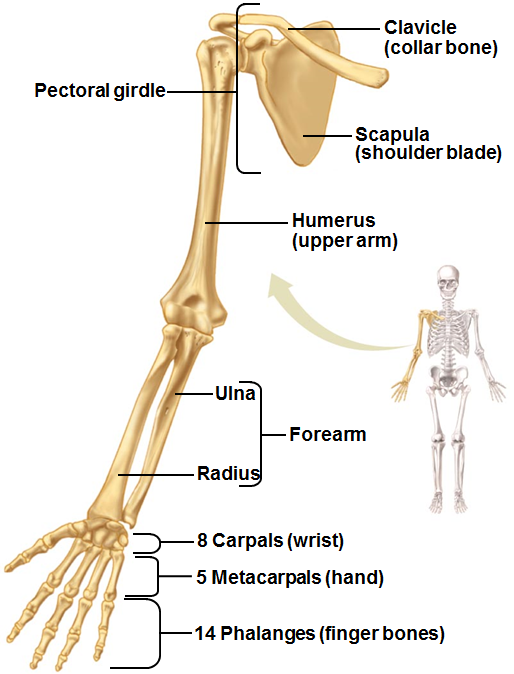Shoulder and Arm
The shoulder is primarily made up of two bones that help to anchor the arm to the body. The clavicle and scapula provide the structural support (with muscles) to anchor the arm to the core of the body.
- Scapula - More commonly known as 'shoulder blade' or shoulder bone' is found on the posterior and superior portions of the shoulder. It can usually be palpated as a ridge of bone going from the shoulder down towards the middle of the back and as a boney protrusion at the superior tip of the shoulder.
- Clavicle - More commonly known as the 'collar bone' is found on the anterior side of the body. It can typically be palpated by starting at the tip of the shoulder (the boney protrusion) follow the line of bone down the anterior side of the shoulder and across the upper portion of the chest until it reaches the sternum.
The arm is comprised of one bone in the upper arm (humerus) and two bones in the forearm (radius and ulna). The wrist has eight bones (carpals) and the hand is comprised of nineteen bones (metacarpals and phalanges).
- Humerus - A large, long bone found in the upper arm. You may be able to palpate this bone on the lateral middle portion of the upper arm.
- Radius - One of the two bones of the forearm found on the thumb side (lateral side in anatomical position). You can palpate a portion of this bone by running your hand down the lateral (thumb side) forearm until you reach just above the wrist and feel a small bump. This first bump is a portion of the radius.
- Ulna - One of the two bones of the forearm found on the 5th digit ('pinky finger') side (medial side in anatomical position). You can palpate a portion of this bone by running your hand down the medial ('pinky' side) forearm until you reach just above the wrist and feel a small bump. This first bump is a portion of the ulna.
- Carpals - This is a grouping of eight bones that allow for all the movement of your wrist. Most of these bones are about the size of a marble.
- Metacarpals - This is a grouping of five bones that run through the palm of your hand.
- Phalanges - This group has fourteen bones. Each digit 2-5 has three phalanges while the thumb only has two phalanges.
Figure 5 - Shoulder and Arm

Image from Johnson Human Biology 6th edition.
|